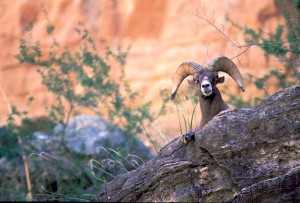Animal life in the Grand Canyon is as diverse as plant life. The unique biospheres provide an abundance of food, water and shelter for all kinds of mammals, reptiles and birds. According to the National Park Service, the Canyon provides habitat for 355 bird species, 89 mammalian species and 56 reptile and amphibian species.
Some species have even evolved specifically to suit themselves to the Grand Canyon’s special elevations and climates. Others are naturally uniquely suited to it. Because of the Grand Canyon Wildlife Program, species are protected, cultivated and studied ensuring their populations will continue to thrive.
 Birds are everywhere in the Grand Canyon. They exist in great variety from songbirds to scavengers to prey birds. Pinyon Jays and Bald Eagles are commonly spotted in and around the Canyon.
Birds are everywhere in the Grand Canyon. They exist in great variety from songbirds to scavengers to prey birds. Pinyon Jays and Bald Eagles are commonly spotted in and around the Canyon.
As scavengers go, you’ll never beat the California Condor. Still on the endangered species list, the Grand Canyon is one of the few places left they can be spotted in the wild. Check out their incredible story <link> on making a comeback from the brink of extinction.
The Peregrine Falcon is another success story often sighted at the Grand Canyon. Their population was brought to frighteningly low numbers when thousands died eating prey that had ingested DDT back in the 1960’s and 70’s. Learn how creative rehabilitation efforts saved this beautiful bird from extinction <link>.
Snakes and Reptiles
When most people think of Arizona, one of the first species that comes to mind is the snake, more specifically, the rattlesnake. While the population of snakes is limited to only a few species at the Grand Canyon, it is the only poisonous snake at the Canyon.
The other venomous reptile found in the Grand Canyon is the Gila Monster, a five foot long giant lizard. They can grow to be between four and five feet in length, quite large for a lizard!
You may also see the smaller Chuckwalla, a lizard about a foot or more in length. These guys are herbivores, so there’s no need to worry if you run into one.
Mammals
 The Grand Canyon is home to some incredibly interesting mammals, carnivores and herbivores alike. Burros offer a storied history as they were an incredible resource for miners in the 1800’s.
The Grand Canyon is home to some incredibly interesting mammals, carnivores and herbivores alike. Burros offer a storied history as they were an incredible resource for miners in the 1800’s.
Big Horn Sheep are some of the more unique herbivores found in the Grand Canyon, thriving in the steep, rocky terrain. Learn more about how they spar each other by crashing forehead to forehead.
Mule Deer are the most conspicuous large mammal in the Grand Canyon.
Mountain Lions were the subject of a renowned study, run by now deceased biologist, Eric York. Learn more about how the tagging and tracking of mountain lions at the Grand Canyon brought this incredible creature back from the verge of extinction.
Fish
As the industrialization of the Colorado River materialized, the fish habitats in the Colorado River were drastically altered. In fact, of the eight native species found in the River before 1963, the Colorado Squawfish, Bonytail Chub and Roundtail Chub are extinct, the Humpback Chub and Razorback Sucker are protected endangered species. Only the Speckled Dace, Flannelmouth Sucker, and Bluehead Sucker are still doing well.
Did You Know? The Wildlife Program at the Grand Canyon plays an important role in preserving and protecting the wildlife native to the area? The program also aims to minimize human impacts to the ecosystems and seek to develop mitigation strategies to combat adverse environmental effects.